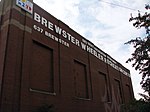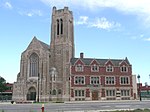Eastern Market, Detroit

Eastern Market is a commercial district in Detroit, Michigan. It is located approximately one mile (1.6 km) northeast of the city's downtown and is bordered on the south by Gratiot Avenue, the north by Mack Avenue, the east by St. Aubin Street, and the west by Interstate 75 (I-75, Chrysler Freeway). It is sometimes referred to as the “Little Italy” of Detroit, although the Italian community has no tight-knit ethnic neighborhood present-day. The district was designated a Michigan State Historic Site in 1974 and listed on the National Register of Historic Places in 1978; the district's boundary was increased in 2007. Eastern Market is located on the city's central east side near St. Joseph Roman Catholic Church and the Lafayette Park neighborhood. The market was transferred from city management in 2006, and now operates through a public-private partnership with the Eastern Market Corporation. Eastern Market is the largest historic public market district in the United States, and the Eastern Market farmers' distribution center is the largest open-air flowerbed market in the United States. There are more than 150 food and specialty businesses. On Saturdays, about 45,000 people shop at the city's historic Eastern Market.
Excerpt from the Wikipedia article Eastern Market, Detroit (License: CC BY-SA 3.0, Authors, Images).Eastern Market, Detroit
Rivard Street, Detroit Midtown
Geographical coordinates (GPS) Address Nearby Places Show on map
Geographical coordinates (GPS)
| Latitude | Longitude |
|---|---|
| N 42.345555555556 ° | E -83.043055555556 ° |
Address
Wolverine Distribution Plant
Rivard Street 2535
48207 Detroit, Midtown
Michigan, United States
Open on Google Maps









